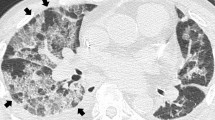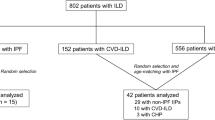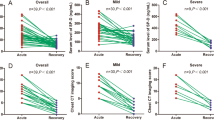Abstract
In forensic cases, detailed identification of pneumonia is important. Our objective was to statistically determine the applicability of three interstitial lung disease (ILD) markers for forensic diagnosis using serum collected from dead bodies with various postmortem intervals (PMIs). We retrospectively analyzed the levels of postmortem serum Krebs von den Lungen-6 (KL-6) and pulmonary surfactant–associated proteins A and D (SP-A and SP-D) using 221 samples obtained during forensic autopsy at our facility from 2019 to 2023. We evaluated the diagnostic efficacy of ILD markers for various pneumonias against the pathological diagnosis, and examined the assessment of the severity of ILD. When comparing the ILD group with bacterial pneumonia (BP) versus the control group, there was a significant increase in KL-6 in the ILD group. When comparing the severe ILD (SILD) group with the mild ILD (MILD) group, there was a significant increase in KL-6 and SP-D in the SILD group. The optimal cutoff values for differentiating SILD were 607.0 U/mL for KL-6, 55.5 ng/mL for SP-A, and 160.0 ng/mL for SP-D, and the sensitivity/specificity (%) of KL-6, SP-A, and SP-D for SILD were 84.1/95.2, 55.6/85.7, and 66.7/74.6, respectively. This is the first study to examine KL-6 in postmortem serum in forensic medicine. By analyzing dead bodies with various PMIs, our results confirmed statistically that postmortem serum KL-6 specifically detects ILD, postmortem serum SP-A has high sensitivity to lung injury, and postmortem serum SP-D is potentially useful in assessing the severity of ILD.



Similar content being viewed by others
Data availability
The datasets generated during and/or analyzed during the current study are available from the corresponding author on reasonable request.
Abbreviations
- ILD:
-
Interstitial lung disease
- KL-6:
-
Krebs von den Lungen-6
- SP-A:
-
Pulmonary surfactant–associated protein A
- SP-D:
-
Pulmonary surfactant–associated protein D
- IIP:
-
Idiopathic interstitial pneumonia
- ARDS:
-
Acute respiratory distress syndrome
- SARS-CoV-2:
-
Severe acute respiratory syndrome coronavirus 2
- COVID-19P:
-
Coronavirus disease 2019 pneumonia
- BP:
-
Bacterial pneumonia
- CRP:
-
C-reactive protein
- PMI:
-
Postmortem interval
- SILD:
-
Severe interstitial lung disease
- MILD:
-
Mild interstitial lung disease
- AP:
-
Alveolar pneumonia
- BrP:
-
Broncho pneumonia
- AsP:
-
Aspiration pneumonia
- PF:
-
Pulmonary fibrosis
- FP:
-
Fungal pneumonia
- OP:
-
Organized pneumonia
- IIP:
-
Idiopathic interstitial pneumonia
- AIDS:
-
Acquired immune deficiency syndrome
- COPD:
-
Chronic obstructive pulmonary disease
- HCC:
-
Hepatocellular carcinoma
- SOP:
-
Secondary organized pneumonia
- ROC:
-
Receiver-operating characteristic
- AUC:
-
Area under the curve
- COP:
-
Cryptogenic organized pneumonia
References
Antoniou KM, Margaritopoulos GA, Tomassetti S, Bonella F, Costabel U, Polettit V (2014) Interstitial lung disease. Eur Respir Rev 23:40–54. https://doi.org/10.1183/09059180.00009113
Ishikawa N, Hattori H, Yokoyama A, Kohno N (2012) Utility of KL-6/MUC1 in the clinical management of interstitial lung diseases. Respir Investig 50(1):3–13. https://doi.org/10.1016/j.resinv.2012.02.001
Kohno N, Akiyama M, Kyoizumi S, Hakoda M, Kobuke K, Yamakido M (1988) Detection of soluble tumor-associated antigens in sera and effusions using novel monoclonal antibodies, KL-3 and KL-6, against lung adenocarcinoma. Jpn J Clin Oncol 18(3):203–216. https://doi.org/10.1093/oxfordjournals.jjco.a039239
Kohno N, Awaya Y, Oyama T, Yamakido M, Akiyama M, Inoue Y, Yokoyama A, Hamada H, Fujioka S, Hiwada K (1993) KL-6, a mucin-like glycoprotein, in bronchoalveolar lavage fluid from patients with interstitial lung disease. Am Rev Respir Dis 148(3):637–642. https://doi.org/10.1164/ajrccm/148.3.637
Shigemura M, Konno S, Nasuhara Y, Shijubo N, Shimizu C, Nishimura M (2013) Serum KL-6 concentrations are associated with molecular sizes and efflux behavior of KL-6/MUC1 in healthy subjects. Clin Chim Acta 424:148–152. https://doi.org/10.1016/j.cca.2013.06.002
Ohnishi H, Yokoyama A, Kondo K, Hamada H, Abe M, Nishimura K, Hiwada K, Konno N (2002) Comparative study of KL-6, surfactant protein-A, surfactant protein-D, and monocyte chemoattractant protein-1 as serum markers for interstitial lung diseases. Am J Respir Crit Care Med 165(3):378–381. https://doi.org/10.1164/ajrccm.165.3.2107134
Chiba H, Otsuka M, Takahashi H (2018) Significance of molecular biomarkers in idiopathic pulmonary fibrosis: a mini review. Respir Investig 56(5):384–391. https://doi.org/10.1016/j.resinv.2018.06.001
Elhai M, Avouac J, Allanore Y (2020) Circulating lung biomarkers in idiopathic lung fibrosis and interstitial lung diseases associated with connective tissue diseases: where do we stand? Semin Arthritis Rheum 50(3):480–491. https://doi.org/10.1016/j.semarthrit.2020.01.006
Hermans C, Bernard A (1999) Lung epithelium-specific proteins: characteristics and potential applications as markers. Am J Respir Crit Care Med 159(2):646–678
Takahashi H, Kuroki Y, Tanaka H, Saito T, Kurokawa K, Chiba H, Sagawa A, Nagae H, Abe S (2000) Serum levels of surfactant proteins A and D are useful biomarkers for interstitial lung disease in patients with progressive systemic sclerosis. Am J Respir Crit Care Med 162(1):258–263. https://doi.org/10.1164/ajrccm.162.1.9903014
Takahashi H, Fujishima T, Koba H, Murakami S, Kurokawa K, Shibuya Y, Shiratori M, Kuroki Y, Abe S (2000) Serum surfactant proteins A and D as prognostic factors in idiopathic pulmonary fibrosis and their relationship to disease extent. Am J Respir Crit Care Med 162(3):1109–1114. https://doi.org/10.1164/ajrccm.162.3.9910080
Bowden DH (1981) Alveolar response to injury. Thorax 36(11):801–804. https://doi.org/10.1136/thx.36.11.801
Crisan-Dabija R, Covic A, Brinza C, Popa IV, Burlacu A (2021) Involvement of KL-6 biomarker in interstitial lung disease induced by SARS-CoV-2 infection: a systematic review. Appl Sci 11(8):3482. https://doi.org/10.3390/app11083482
Di Wu, Tiantian Wu, Liu Q, Yang Z (2020) The SARS-CoV-2 outbreak: what we know. Int J Infect Dis 94:44–48. https://doi.org/10.1016/j.ijid.2020.03.004
Ghati A, Dam P, Tasdemir D, Kati A, Sellami H, Sezgin GC, Ildiz N, Franco OL, Mandal AK, Ocsoy I (2021) Exogenous pulmonary surfactant: a review focused on adjunctive therapy for severe acute respiratory syndrome coronavirus 2 including SP-A and SP-D as added clinical marker. Curr Opin Colloid Interface Sci 51:101413. https://doi.org/10.1016/j.cocis.2020.101413
Ishida K, Zhu B-L, Li Quan MQ, Fujita MH (2000) Pulmonary surfactant-associated protein A levels in dead cadaveric sera with reference to the cause of death. Forensic Sci Int 109(2):125–133. https://doi.org/10.1016/S0379-0738(99)00228-5
Quan Li, Zhu B-L, Ishikawa T, Michiue T, Zhao D, Yoshida C, Chen J-H, Wang Qi, Komatsu A, Azuma Y, Maeda H (2009) Postmortem serum levels of pulmonary surfactant-associated proteins A and D with regard to the cause of death in medicolegal autopsy. Leg Med 11:S301–S303. https://doi.org/10.1016/j.legalmed.2009.01.011
Ikeda K, Ichihara K, Hashiguchi T, Hidaka Y, Kang Dongchon, Maekawa M, Matsumoto H, Matsushita K, Okubo S, Tsuchiya T, Furuta K, on behalf of The Committee for Standardization, The Japanese Society of Laboratory Medicine (2015) Evaluation of the short-term stability of specimens for clinical laboratory testing. Biopreserv Biobank 13(2):135–143. https://doi.org/10.1089/bio.2014.0072
Ode H, Nakata Y, Nagashima M, Hayashi M, Yamazaki T, Asakura H, Suzuki J, Kubota M, Matsuoka K, Matsuda M, Mori M, Sugimot A, Imahashi M, Yokomaku Y, Sadamasu K, Iwatani Y (2022) Molecular epidemiological features of SARS-CoV-2 in Japan, 2020–1. Virus Evol 8(1):veac034. https://doi.org/10.1093/ve/veac034
Hirotsu Y, Maejima M, Shibusawa M, Kakizawa Y, Miyashita Y, Omata M (2022) SARS-CoV-2 Omicron sublineage BA.2 replaces BA.1.1: genomic surveillance in Japan from September 2021 to March 2022. J Infect 85(2):174–211. https://doi.org/10.1016/j.jinf.2022.04.040
Doyle IR, Nicholas TE, Bersten AD (1995) Serum surfactant protein-A levels in patients with acute cardiogenic pulmonary edema and adult respiratory distress syndrome. Am J Respir Crit Care Med 152(1):307–317. https://doi.org/10.1164/ajrccm.152.1.7599839
Netsu S, Shishido T, Arimoto T, Takahashi H, Miyashita T, Miyamoto T, Nitone J, Kubota I (2010) Serum surfactant protein D reflects pulmonary congestion in patients with chronic heart failure. J Cardiac Fail 16(9):S169. https://doi.org/10.1016/j.cardfail.2010.07.200
Cheng Ivan W, Ware Lorraine B, Greene Kelly E, Nuckton Thomas J, Eisner Mark D, Matthay Michael A (2003) Prognostic value of surfactant proteins A and D in patients with acute lung injury*. Soc Crit Care Med 31(1):20–27
Chiba H, Takahashi H (2016) Specific serum markers of IPF. Idiopathic Pulmonary Fibrosis. Springer, Tokyo, pp 61–76. https://doi.org/10.1007/978-4-431-55582-7_5
Palmiere C, Mangin P (2012) Postmortem chemistry update part II. Int J Legal Med 126:199–215. https://doi.org/10.1007/s00414-011-0614-1
Cordier J-F (2006) Cryptogenic organising pneumonia. Eur Respir J 28:422–446. https://doi.org/10.1183/09031936.06.00013505
Hara Y, Kano S, Fujikura Y, Kawano S, Kanzaki Y, Misawa K, Shinkai M, Kawana A (2014) Clinical significance of serum KL-6 levels in organizing pneumonia proven by lung biopsy. Japan Soc Bronchol 36(4):348–52. https://doi.org/10.18907/jjsre.36.4_348
Okada F, Ando Y, Honda K, Tanoue S, Matsumoto S, Mori H (2009) Comparison of pulmonary CT findings and serum KL-6 levels in patients with cryptogenic organizing pneumonia. Br J Radiol 82(975):212–218. https://doi.org/10.1259/bjr/72775434
Yamagishi T, Kodaka N, Watanabe K, Nakano C, Oshio T, Niitsuma K, Shimada N, Matsuse H (2020) A retrospective clinical research of relapsed organizing pneumonia. Ann Thorac Med 15(1):15–20. https://doi.org/10.4103/atm.ATM_311_19
Donaldson AE, Lamont IL (2014) Estimation of post-mortem interval using biochemical markers. Aust J Forensic Sci 46(1):8–26. https://doi.org/10.1080/00450618.2013.784356
Butzbach DM (2010) The influence of putrefaction and sample storage on post-mortem toxicology results. Forensic Sci Med Pathol 6:35–45. https://doi.org/10.1007/s12024-009-9130-8
Chen J-H, Inamori-Kawamoto O, Michiue T, Ikeda S, Ishikawa T, Maeda H (2015) Cardiac biomarkers in blood, and pericardial and cerebrospinal fluids of forensic autopsy cases: a reassessment with special regard to postmortem interval. Leg Med 17(5):343–350. https://doi.org/10.1016/j.legalmed.2015.03.007
Lorente JA, Lorente M, Villanueva E (1992) Postmortem stability of lung surfactant phospholipids. J Forensic Sci 37(5):1341–1345. https://doi.org/10.1520/JFS13322J
Acknowledgements
We thank Edanz (https://jp.edanz.com/ac) for editing a draft of this manuscript.
Author information
Authors and Affiliations
Contributions
KO, KH, and CM performed the measurements. GI, H Iwase, H Inoue, AM, NI, TS, and DY reviewed this manuscript. GI supervised the study.
Corresponding author
Ethics declarations
Ethical approval
This study was conducted with the approval of the Human Research Ethics Committee of the University of the International University of Health and Welfare, School of Medicine (ethics approval number: 19-Im-019).
Consent to participate
Because all the subjects of this study are the dead bodies, it is impossible for us to obtain the informed consent from them. However, we are making an effort to obtain the informed consent of the families and/or other interested parties of the dead bodies through an opt-out method via leaflets and our website.
Research involving human participants and/or animals
This study was performed with human dead bodies. This manuscript does not contain any studies with (living) human participants or animals performed by any of the authors.
Conflict of interest
The authors declare no competing interests.
Additional information
Publisher's Note
Springer Nature remains neutral with regard to jurisdictional claims in published maps and institutional affiliations.
Rights and permissions
Springer Nature or its licensor (e.g. a society or other partner) holds exclusive rights to this article under a publishing agreement with the author(s) or other rightsholder(s); author self-archiving of the accepted manuscript version of this article is solely governed by the terms of such publishing agreement and applicable law.
About this article
Cite this article
Okaba, K., Inokuchi, G., Horioka, K. et al. Forensic application of three interstitial pneumonia markers: search for new pneumonia markers in dead bodies. Int J Legal Med (2024). https://doi.org/10.1007/s00414-024-03187-2
Received:
Accepted:
Published:
DOI: https://doi.org/10.1007/s00414-024-03187-2




